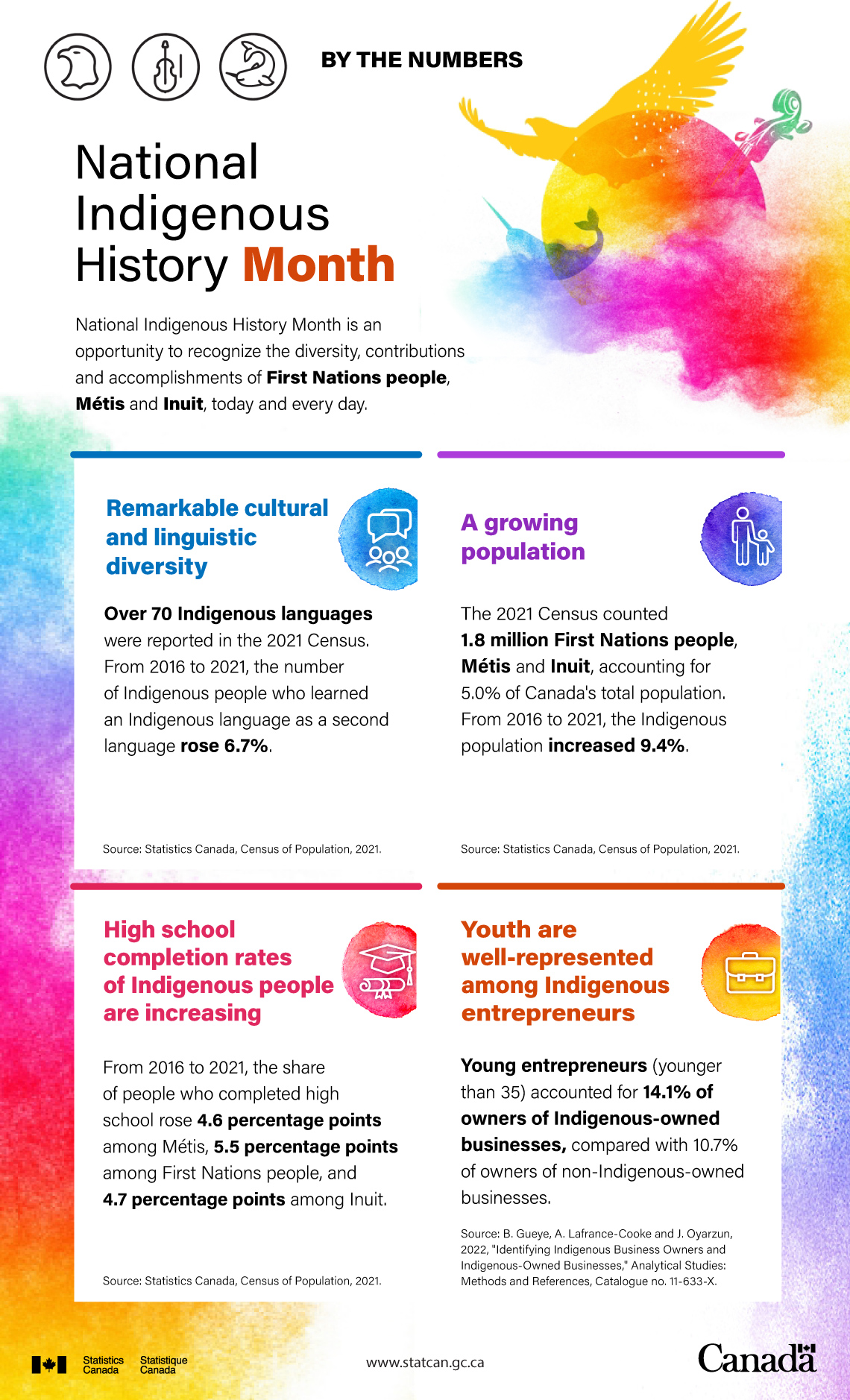
Demography
- The 2021 Census counted 1.8 million Indigenous people, accounting for 5.0% of the total population in Canada.
- For the first time, the 2021 Census counted more than 1 million First Nations people living in Canada (1,048,405).
- There were 624,220 Métis living in Canada in 2021, up 6.3% from 2016.
- The Inuit population in Canada numbered 70,545, with just over two-thirds (69.0%) living in Inuit Nunangat—the homeland of Inuit in Canada.
- The average age of Indigenous people was 33.6 years in 2021, compared with 41.8 years for the non-Indigenous population.
- The Indigenous population grew by 9.4% from 2016 to 2021, almost twice the pace of growth of the non-Indigenous population over the same period (+5.3%).
- Population projections for First Nations people, Métis and Inuit suggest that the Indigenous population could reach between 2.5 million and 3.2 million in 2041.
Sources:
- The Daily — Indigenous population continues to grow and is much younger than the non-Indigenous population, although the pace of growth has slowed
- Indigenous Population in Canada - Projections to 2041
Children and Youth
- There were 459,215 Indigenous children under 15 years old in 2021, accounting for one-quarter (25.4%) of the total Indigenous population. By comparison, 16.0% of the non-Indigenous population was under 15 years old.
- For First Nations, Métis and Inuit families, grandparents often play an important role in raising children and passing down values, traditions and cultural knowledge to younger generations. In 2021, 14.2% of Indigenous children lived with at least one grandparent, compared with 8.9% of non-Indigenous children.
- The majority (56.0%) of Indigenous children lived in a two-parent household in 2021. However, more than one-third (35.8%) of Indigenous children lived in a one-parent household.
- Altogether, Indigenous children accounted for over half (53.8%) of all children in foster care, while nationally, Indigenous children accounted for 7.7% of all children 14 years of age and younger.
Sources:
Education
- According to the 2021 Census, nearly three-quarters (73.9%) of Indigenous people aged 25 to 64 had completed high school, and 12.9% had a bachelor's degree or higher.
- Gaps between the Indigenous and the non-Indigenous population are narrowing when it comes to high school completion. The share of Métis who had completed high school rose 4.6 percentage points from 2016, to 82.0% in 2021, while for First Nations people, the share increased 5.5 percentage points to 69.9%. For the first time, in 2021, over half (50.1%) of Inuit aged 25 to 64 had completed a high school diploma or equivalency certificate, up 4.7 percentage points from 2016. In all these cases, these increases in the share of Indigenous populations with a high school diploma were larger than among the Canadian-born non-Indigenous population (+2.0 percentage points), 88.9% of whom had completed high school.
- However, gaps between the share of the Indigenous and the non-Indigenous population completing a bachelor's degree or higher are widening. Although the share of Indigenous people with a bachelor's degree or higher rose by 1.9 percentage points (to 12.9%) in 2021, this was less than the increase among the Canadian-born non-Indigenous population (+2.9 percentage points, to 27.8%). This trend held true among Métis (+2.5 percentage points, to 15.7%), First Nations people (+1.6 percentage points, to 11.3%) and Inuit (+0.9 percentage points, to 6.2%).
Sources:
Indigenous Languages
- Over 70 Indigenous languages were reported in the 2021 Census, with 237,420 Indigenous people reporting that they could speak an Indigenous language well enough to conduct a conversation. This represents 13.1% of the Indigenous population.
- The most commonly spoken Indigenous languages among Indigenous people were Cree languages, with 86,480 speakers, followed by Inuktitut and Ojibway languages.
- The majority (72.3%) of Indigenous people who could speak an Indigenous language reported that they had an Indigenous language as their mother tongue.
- However, the number of Indigenous people who could speak an Indigenous language but did not have an Indigenous mother tongue grew by 7.0% over the same period. This change reflects a growing share of Indigenous people who are learning an Indigenous language as a second language.
Sources:
- The Daily — Indigenous population continues to grow and is much younger than the non-Indigenous population, although the pace of growth has slowed
- Indigenous languages in Canada, 2021
Health and well-being
- During the first year of the pandemic, mental health conditions such as depression and anxiety were the leading chronic conditions reported with about one in five Indigenous adults reporting these, compared with one in ten non-Indigenous adults. Mental health challenges among Indigenous people have been linked to the effects of intergenerational trauma stemming from colonialism as well as social determinants of health such as poverty, unemployment, housing and food security.
- During the pandemic, in 2021, First Nations people (11%), Métis (8%) and Inuit (19%) were about two to five times more likely than non-Indigenous people (4%) to report exposure to some form of discrimination in health care.
- Rates of disability among First Nations people living off reserve and Métis were higher than for non-Indigenous people in 2017. Almost one-third of both First Nations people living off reserve (32%) and Métis (30%) aged 15 and older reported having at least one disability in 2017, compared with 22% among the non-Indigenous population. Among Inuit, that proportion was lower (19%), largely because Inuit are a younger population.
